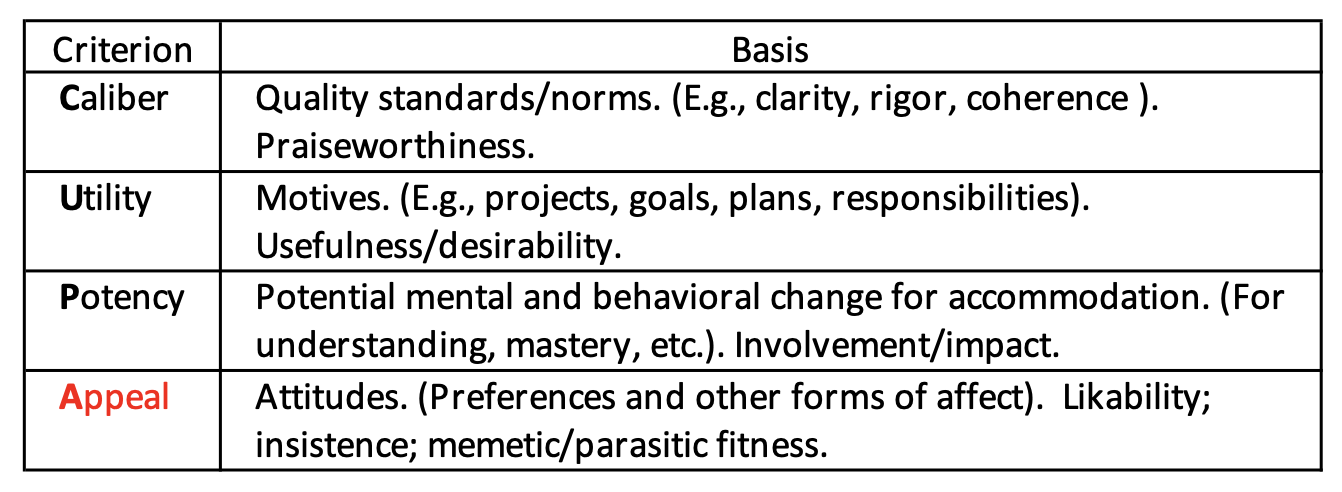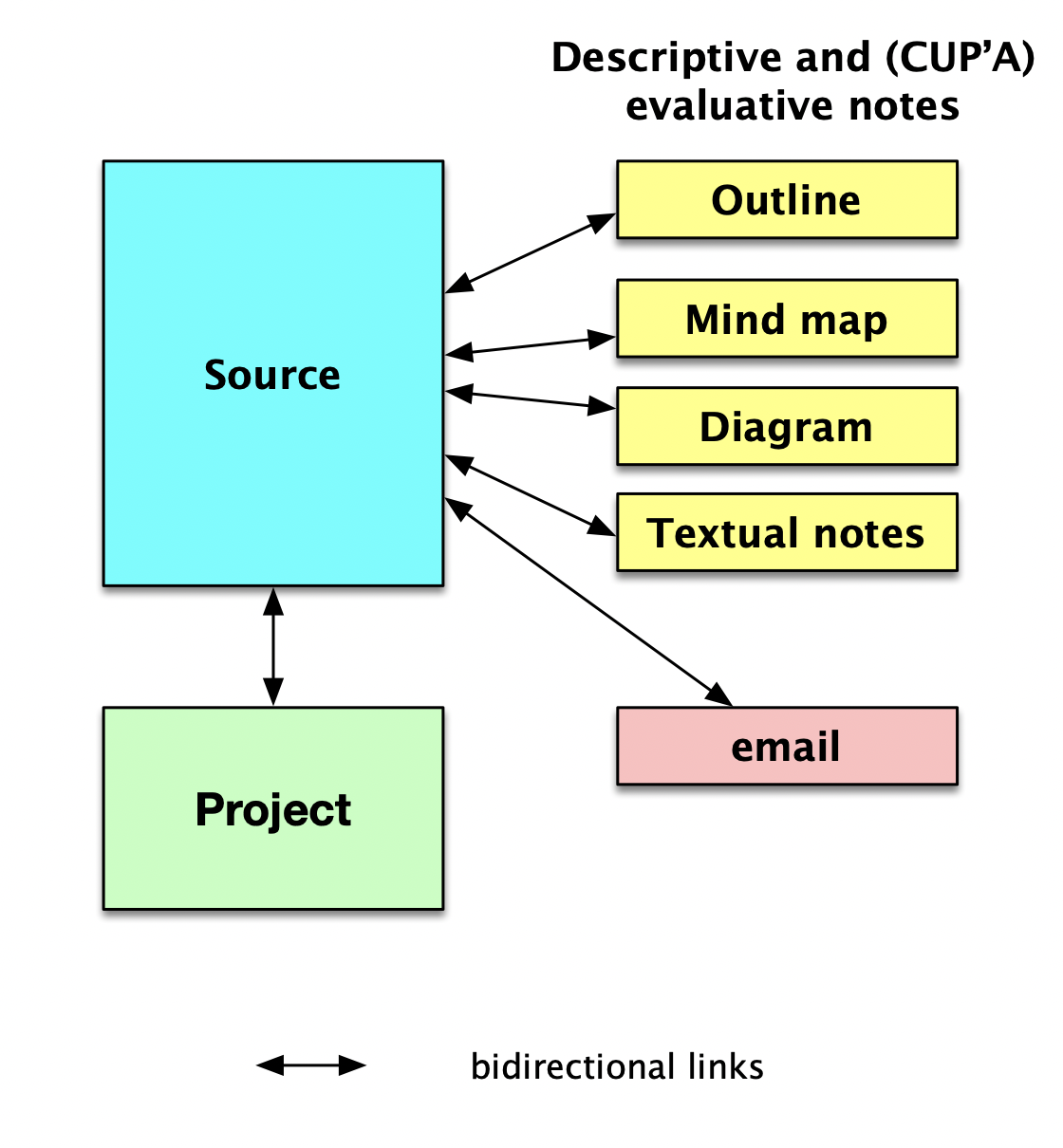It is remarkably important and yet equally difficult to adequately:
- assess and select resources (papers, videos, etc.) in an age with so much information one could process;
- understand what’s even involved in assessing resources generally (i.e., how we select what to read or watch); and
- devise general strategies to guide the selection and assessment of resources.
The CUP’A framework , which is described in the first two Cognitive Productivity books is an attempt to make progress on these problems.
Originality of the framework
As noted in the introduction below, the CUP’A framework is original in many ways. It is also perhaps the first assessment framework to systematically distinguish different forms of value (caliber, utility and potency) and to articulate a concept of potency.
It also seems to be the first framework to link insistence to memetic and parasitic fitness. Memetic fitness is the propensity of information to spread between people; parasitic fitness is a subset of this that applies to self-defeating information. “Parasitic fitness” is a term coined by Gad Saad in his 2020 book, The Parasitic Mind. He also coined the terms “idea pathogen” and “mental parasite”, which are related to what Keith Stanovich called “infected mindware”. Saad’s failing to acknowledge Keith Stanovich seems to be an error of omission. Stavich’s work is discussed in the Cognitive Productivity books.
Insistence is a concept that was first proposed by Aaron Sloman. Beaudoin followed up on it in his Ph.D. thesis on goal processing in autonomous agents, a recent paper (Perturbance: Unifying Research on Emotion, Intrusive Mentation and Other Psychological Phenomena with AI) and elsewhere. To a first approximation, insistence is the propensity for information to captivate executive functions. Technical concepts of anger, grief and infatuation have been defined in terms of insistent motivators. Insistence is a bottom-up property.
Insistent information can unlock the potential of potency. For instance, if one is continually drawn to use information it can reshape one’s thinking.
More work is required to formalize the CUP’A concepts.
Chapter in 2021 Future of text book
Luc P. Beaudoin wrote a brief chapter on the CUP’A framework: Beyond the CRAAP test and other introductory guides for assessing knowledge resources: The CUP’A framework which was published in Volume II of The Future of Text book edited by Frode Hegland (2021).
The Future of Text book deals with future information-processing technologies; so Beaudoin’s chapter also deals with technical requirements and implications of assessing resources.
The rest of this webpage provides some information about the paper. But for full details on CUP’A please refer to the two Cognitive Productivity books.
Excerpt from chapter in Future of Text book
intro
You are overloaded with documents to read and write. So I must immediately convince you that this chapter is sufficiently useful for you to read it. Assessing knowledge resources is a constitutive skill of knowledge work that requires ongoing attention, and should not be allowed to fossilize upon graduation.
Here I present the CUP’A framework for assessing knowledge resources factually and pragmatically. In contrast to frameworks one finds in study skills texts (e.g., the CRAAP test), philosophy of science and elsewhere, this framework:
- is developed not only for students but also for professional knowledge workers;
- is inscribed in integrative design-oriented psychology;
- includes suggestions for using information-processing software in powerful ways; and
- functionally specifies information-processing software (the ‘future of text’).
The CRAAP schema advises you to consider the currency, relevance, authority, accuracy, purpose and point of view of information. The CUP’A schema assists in assessing the caliber (C), utility (U) and potency (P) of information, while sensitizing one to the seductive dangers of appealingness (A).
The CUP’A criteria and their bases are summarized below.
Table 1. CUP’A Assessment Criteria

We suggest that trying to treat these evaluation criteria independently is important but difficult. In particular, judgments of utility and appeal can contaminate judgments of caliber.
Assessment of sources is highly relational
When we assess information we do so in relation to a lot of other information. A given paper for instance may be pertinent to one or more projects. Being able to connect a paper to a project is important. This connection reflects value of the paper. A paper that is worth explicitly connecting to a project is more valuable than a random resource. The importance of the project may lend importance to a paper.
Also one’s assessments of information may be recorded in different locations, such as mind-maps, outlines, notes, spreadsheets, projects, emails and more. For instance, a user might receive more or less detailed positive or negative feedback via email about a paper s/he is reading. This information “extends one’s brain”.

Figure 1. Example types of documents that may contain information from which an assessment of a source may be constructed
This entails a role for software like CogSci Apps’ Hook productivity app for macOS (coming to iPhone/iPad), because Hook allows users to connect documents (and other resources) to anything linkable, including mind-maps, outlines, notes, spreadsheets, projects and more — each of which may contain information that evaluates one or more sources (papers, videos, podcasts, etc.)
Literature
- The chapter: Beyond the CRAAP test and other introductory guides for assessing knowledge resources: The CUP’A framework.
- The broader framework: On applying integrative design-oriented cognitive science to hypertext: a framework for cognitive productivity
Bibliography of The Future of Text chapter
- Beaudoin, L. P. Cognitive Productivity with macOS: 7 Principles for Getting Smarter with Knowledge
- Beaudoin, L. P. Cognitive Productivity: Using Knowledge to Become Profoundly Effective
- Lindsay, J. A. & Pluckrose, H. Cynical Theories
- Saad, G. The Parasitic Mind
- Sloman, A. The Computer Revolution in Philosophy_., particularly chapter 2: What Are the Aims of Science?.
- Wrangham, R. W. The Goodness Paradox: The Strange Relationship Between Virtue and Violence in Human Evolution
Revision history
- 2023-02-17: added links to the paper and context.
- 2021-10-31: fixed bibliography typo.
- 2021-09-12: edited bibliography.
- 2021-09-11: first substantial publication of this page.
